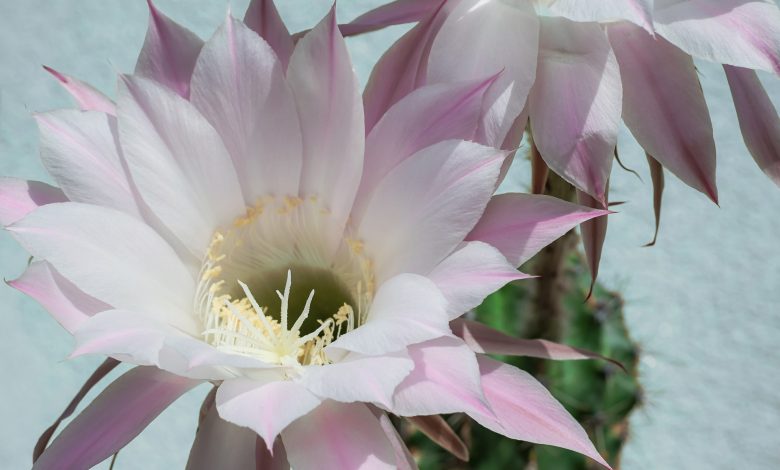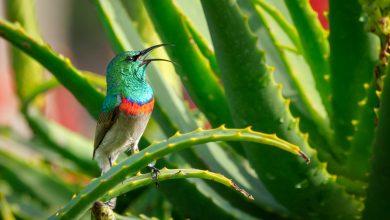How to Care for Queen of the Night Cactus

Cactus plants provide growers with a unique combination of attractive looks and ease of care. The queen of the night is no exception. Although its magnificent blooms only appear at night, the queen is still revered during the day. Also referred to as the orchid cactus, the queen of the night is incredibly distinctive as far as cacti go, and its uniqueness goes far beyond its stunning flowers. In this article, we’ll show you how to care for the queen of the night cactus and when to view its flowers.
Botanical Information
The queen of the night is a member of the cactus family, known as Cactaceae. The botanical name for the queen of the night is the Epiphyllum oxypetalum.
Native Habitat
The Epiphyllum oxypetalum is native to the dry regions of South America and Mexico.
Flower
When fully opened, the flower appears like a magnificent waterlily, with a base of thin petals spread out flat around upward curling white flowers. The flowers increase their intoxicating effect with sweet aromas, but the majesty of the flower can only be enjoyed from dusk until dawn.

Appearance
The overall appearance of the plant does not resemble a traditional cactus. Just as with all members of the epiphyte family, the queen of the night typically grows on other plants in the wild. In its natural habitat, it would be common to see the queen of the night wrapped around a tree with several flowers blooming at once.
Small, spineless branches grow from the narrow base of the plant with flowers protruding at the tips. To enjoy the full experience of the Epiphyllum oxypetalum, you do not need to be a night owl or an early riser, but those that are can enjoy the bloom for longer. Flowers typically begin to open around 8 p.m. and stay open until around 10 in the morning. The flowers will start to wilt if they receive too much morning sunlight.
Unfortunately, each flower opens for just one night. Each night will have a new flower blooming, so make sure to pay attention to the plant during its blooming period to ensure that you do not miss the majestic flowers.
Leaves
The leaves of the plant are slender and do not resemble leaves you would expect to find on a cactus plant. They are also not technically leaves, but modified stems, although they appear as a typical leaf would. One of the main functions of the leaves is that they are reabsorbed as nutrients by the plant after falling to the ground.
Hardiness Zone
The queen of the night thrives in U.S. Department of Agriculture hardiness zones 10 to 12, which limits its outside growth to southern Florida and southern California. In colder climates, the queen of the night can be grown as a house plant.

How to Care for Queen of the Night Cactus
The queen of the night is an undemanding plant that requires little attention as it grows. If you live inside of hardiness zones 10 to 12, take advantage of growing this cactus outside. The more room it has to spread out, the better. And the fun part is that you never know quite where it will grow and what the finished product will look like.
As a houseplant, the queen of the night is best used in hanging baskets. As a plant that is used to growing around the trunks of trees, it’s helpful to give it as much space as possible to spread out. The stems will begin cascading out of the basket and provide unique interest.
Sunlight
While typically one would assume that a cactus plant wants to soak up as much sun as possible, that is not the case for the queen of the night. The best place to plant the queen of the night would be below some larger shrubs to provide it with shade for part of the day. Surrounding the queen of the night with other plants will also provide support and a clear path for growth.
If your queen of the night receives morning sun, it may produce more flowers. Be careful, though, not to provide it with too much sunlight. If you notice its stems becoming yellow, it may be receiving too much light.
Water
As with all cacti and other members of the succulent family, the queen of the night requires minimal watering. Overwatering the plant can cause root rot, which could ultimately kill it. During the growing season, from spring through fall, you should water the plant once every two weeks. If you are growing it outside and there has been a particularly hot and dry period, you can water the plant whenever you notice that the soil has completely dried out.
Soil
Queen of the night grows most effectively in soil that is slightly acidic, with a pH ideally between 5.5 and 6.5. A well-draining soil will be most effective. If your soil has too much clay, try mixing in a layer of leaf mulch with a sandy soil mixture. The leaf mulch will lighten up a heavier soil and will help the sandy soil with its moisture control.
Fertilizer
During the growing season, you can apply fertilizer once a month. Look for a cactus specific fertilizer. If one is not available, make sure to use a fertilizer that has a low level of nitrogen. Using too much nitrogen will cause the plant to grow larger, but it will reduce the number of flowers it produces.
When you look at fertilizer, you will see three numbers, such as 10-10-10. Each number represents a different nutrient, with the first representing nitrogen, the second representing phosphate, and the third representing potash. In the absence of fertilizer, apply compost to the base of the plant if you have some available.
Temperature
The queen of the night will grow well in a wide range of temperatures, from 50 degrees to 90 degrees Fahrenheit. Temperatures below 35 degrees Fahrenheit will kill the plant.
Pests
The main area of concern for this plant is keeping an eye out for a fungal leaf spot, especially in the spring. Signs of a fungal leaf spot will be moldy patches that appear fuzzy on the plant’s leaves. You want to catch this disease quickly, as it can be hard to treat. If there are only a few afflicted leaves, a fungicide may work best to get rid of the fungal leaf spots. If there are many different afflicted areas of the plant, it is best to cut off the unhealthy parts to allow the plant to regrow.
Propagation
You can propagate the plant using both its stems and its leaves. You just need to remember which side of the leaf is down and insert that part into the soil. Whichever way you choose to propagate, let the stem or leaf dry out for a few days until the cut area has callused. Then, place the stem or leaf a few inches into the soil. After about a week, roots should begin germinating. You can also choose to get the roots germinating by placing the cutting in a glass of water and then transferring to a pot.
Medicinal Uses
As you may expect for a plant this unique, it also has various medicinal purposes. The plant has been shown to provide anti-inflammatory, antioxidant, and antimicrobial properties. In the past, it has been used to treat a cough and bloody phlegm, as well as shortness of breath.
Cultural Significance
The mysterious queen of the night plant is meaningful to multiple cultures:
- In India, the plant is called Bramhakamal and is thought to bring good luck and prosperity during the rainy season, from mid-June to September. Some believe that while the flower is blooming, prayers will be fulfilled.
- The Chinese use the plant to refer to someone that has a brief flash of glory. This reference could mean either someone got lucky once, or someone is an exception to a rule.
- Indonesians call the flower “Wijaya Kusuma,” meaning flower of triumph.
- Sri Lankans call it “Kadupul,” meaning flower from heaven.

Other Night Flowering Plants
The Epiphyllum oxypetalum is often mischaracterized as the night-blooming Cereus plant, belonging to the Cereeaea family. Some versions of this plant, such as the Selenicereus grandiflorus, bloom just one night each year. This plant is also confused with the Epiphyllum oxypetalum due to its nickname “princess of the night.” The dried flowers from the Cereus plant are a popular ingredient in slow-simmering Cantonese soup.
Another variety of night-blooming cactus plants that might be more recognizable is the Hylocereus undatus, which is also known as the Honolulu queen. This particular queen is best known for its pitahaya fruit, also known as dragon fruit.
The reason these plants are often mischaracterized is how similar their flowers appear. Almost every one of them features a white or pale-colored flower, which only blooms at night.
Here is a full list of the cacti plants which may be referred to as night-bloomers and often get confused with each other:
- Cereus
- Echniopsis
- Epiphyllum
- Harrisia
- Hylocereus
- Monvillea
- Nyctocereus
- Peniocereus
- Selenicereus
- Trichocereus



